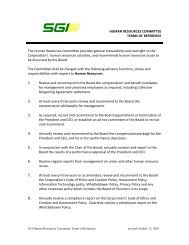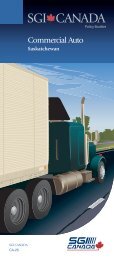Full report - SGI Canada
Full report - SGI Canada
Full report - SGI Canada
Create successful ePaper yourself
Turn your PDF publications into a flip-book with our unique Google optimized e-Paper software.
2010 2009<br />
Source: <strong>SGI</strong> CANADA and MSA Research<br />
*2010 - Industry Estimates<br />
In 2011, <strong>SGI</strong> CANADA’s growth strategy will be measured using a consolidated gross premium written<br />
target of $509.5 million.<br />
Consolidated combined ratio<br />
This ratio is a key profitability measure for the Corporation. It measures the underwriting profit or loss for<br />
a company for a period of time. The combined ratio is calculated as total expenses (claims and other<br />
expenses, excluding income taxes and minority interest) divided by net premiums earned. Insurance<br />
companies attempt to achieve a ratio of less than 100%, which represents an underwriting profit.<br />
The Corporation’s average combined ratio over the previous 10-year period was 98%, slightly better than<br />
the industry average of 99%.<br />
P&C Industry vs. <strong>SGI</strong> CANADA Consolidated Combined Ratio<br />
<strong>SGI</strong> CANADA’s consolidated combined ratio for 2010 was 96.8%, exceeding its target of 98.0%. The 96.8%<br />
combined ratio marks the eighth consecutive year that <strong>SGI</strong> CANADA has achieved a profit from its core<br />
activity of underwriting insurable risks. Strong performance from Saskatchewan, Alberta and the Maritime<br />
operations was key in achieving the positive underwriting results in 2010.<br />
While in recent years <strong>SGI</strong> CANADA has achieved a consolidated combined ratio below 100%, the<br />
Corporation understands that each jurisdiction may not reach that target every year. Instead, geographic<br />
diversification helps the Corporation limit its insurance risk in any one geographic area by allowing it to<br />
maintain a strong combined ratio while experiencing high claim costs in certain markets. In 2010 the<br />
Saskatchewan, Alberta and Maritime operations achieved the targeted 98% combined ratios, while<br />
Ontario and Manitoba operations did not. Ontario experienced high automobile claim costs, while<br />
Manitoba had a high number of large property losses during the year.<br />
The 2011 target is a consolidated combined ratio of 93.4%.<br />
Capability to Execute Strategies<br />
Fundamental to the capability to execute corporate strategies, manage key performance drivers and<br />
deliver results are the Corporation’s employees, brokers, technology and financial capital. They are<br />
discussed further below:<br />
Employees<br />
<strong>SGI</strong> CANADA’s management team is experienced and knowledgeable about the Canadian P&C insurance<br />
market. Many of the Corporation’s employees are long-term with an average length of approximately<br />
15 years of employment, and the staff turnover rate for the last five years has averaged 6%. Due to this long<br />
tenure and low turnover, the Corporation has significant expertise in the core underwriting and claims<br />
handling areas of its business, as well as within its support areas. This expertise has contributed to<br />
<strong>SGI</strong> CANADA’s superior loss ratio and combined ratio in the Saskatchewan market, compared to the<br />
insurance industry overall. This expertise is also crucial to its success in markets outside Saskatchewan.<br />
Maintaining this expertise is key to meeting the challenges that will present themselves in the future.<br />
<strong>SGI</strong> CANADA is projecting a significant level of retirements in the near future as a large portion of its<br />
workforce reaches retirement age. In fact, nearly 32% of the Corporation’s employees are expected<br />
to retire, or be eligible for retirement, by 2018. The challenge is to recruit and retain the best people to<br />
ensure the longevity, growth and maintenance of <strong>SGI</strong> CANADA’s competitive position for the future. The<br />
Corporation has developed a workforce-planning model that includes Aboriginal employment, youth<br />
employment, management development and expanded performance management strategies. This model<br />
will assist in transitioning expertise as retirements occur.<br />
On December 31, 2009, the three-year Collective Bargaining Agreement (CBA) between <strong>SGI</strong> and<br />
<strong>SGI</strong> CANADA Insurance Services Ltd., and the Canadian Office and Professional Employees’ Union, Local<br />
397 (COPE 397) expired. The bargaining committee is currently in negotiations with respect to reaching<br />
a new agreement. This agreement applies to all in-scope employees at <strong>SGI</strong>. <strong>SGI</strong> has not had a work<br />
stoppage since 1948, and it will continue to work with COPE 397 to ensure that this record continues into<br />
the future.<br />
Brokers<br />
<strong>SGI</strong> CANADA sells its products through a network of 256 independent brokers who conduct business<br />
from 367 offices throughout Saskatchewan, and 249 brokers who operate 553 offices throughout the rest<br />
of <strong>Canada</strong>. In order to continue delivering insurance products that customers desire, <strong>SGI</strong> CANADA works<br />
closely with brokers to obtain input and advice on the changing needs of customers. With the assistance<br />
of brokers, <strong>SGI</strong> CANADA is able to take a lead in delivering innovative insurance products to its customers.<br />
30 | 2010 MANAGEMENT’S DISCUSSION AND ANALYSIS MANAGEMENT’S DISCUSSION AND ANALYSIS 2010 | 31















